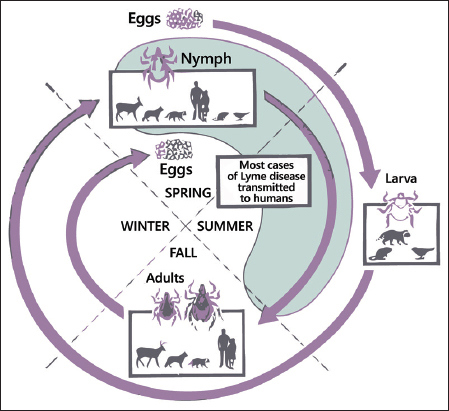Deer Tick Life Cycle and Active Periods


1. What Came First: The Tick or the Egg?
The life cycle of a deer tick lasts about two years and begins in the early spring when an adult female engorged (full) with blood lays fertilized eggs.
Deer tick eggs hatch into larvae in the late summer months, during which time they take one blood meal from a small mammal or bird. At this point, larval deer ticks are at risk for contracting diseases such as Lyme if they feed on an infected animal.
Engorged larvae will become dormant over the fall, using the blood for energy to molt into their next life stage.
2. Ch-Ch-Ch-Ch-Changes: From Larva to Nymph
Once spring arrives, the deer tick nymphs become active again and are most prevalent between May and August. During this time, they will take their second blood meal, usually from another small to medium sized animal.
Nymph blacklegged ticks are most known for transmitting Lyme disease to humans because their small size allows them to go undetected and feed for a longer period of time, increasing the risk of disease transmission.

3. A Tale of Two Ticks
Following their blood meal, deer tick nymphs will molt into an adult male or adult female during the fall months. Adult female deer ticks will take their third and final blood meal on large animals such as white-tailed deer, black bears, or cattle. Adult males will rarely feed and instead seek an engorged adult female to mate with.
Once the adult male has mated with the adult female, he will die and she will fall off of the host and become dormant overwinter, preparing to lay eggs in the spring. She will lay 2,000-4,000 eggs and die leaving the eggs to hatch during the summer.
